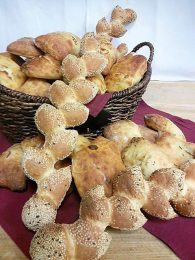 “Find Your Fun” and have some fun with food! A new contest for county fairs and the State Fair has been developed by the Kansas Wheat Commission to bring out your creativity with bread sculptures.
“Find Your Fun” and have some fun with food! A new contest for county fairs and the State Fair has been developed by the Kansas Wheat Commission to bring out your creativity with bread sculptures.
The Kansas Wheat Commission recommends having a county contest to send the winner on to the State Fair. But, individuals may still enter their item in the “Open Class” Bread Sculpture contest at the State Fair.
Judges will consider creativity, originality, imagination, attention to detail, design, color, and instructions.
For more information, the contest flyer can be found at http://www.rrc.k-state.edu/judging/index.html under “Foods & Nutrition.”
For questions, please contact kswheat@kswheat.com or Nicole.Jaskoski@ks.gov
